We Strive for Healthy Habitat
Healthy habitat is k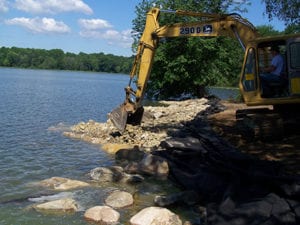 ey to having a high quality aquatic recreational experience. Whether it be fishing, boating, swimming or simply enjoying a shoreline picnic, the measure of the experience is inextricably linked to the habitat quality. Impacts to healthy reservoirs include aging reservoirs, sedimentation and erosion, connectivity, limited littoral habitat, and water level fluctuation. Let's delve a little deeper into each of these issues.
ey to having a high quality aquatic recreational experience. Whether it be fishing, boating, swimming or simply enjoying a shoreline picnic, the measure of the experience is inextricably linked to the habitat quality. Impacts to healthy reservoirs include aging reservoirs, sedimentation and erosion, connectivity, limited littoral habitat, and water level fluctuation. Let's delve a little deeper into each of these issues.
Aging Reservoirs
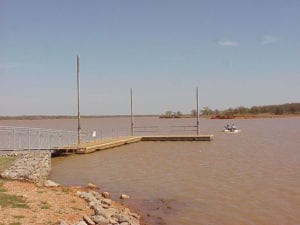 Reservoir construction peaked in the 1950’s through 1970’s making most reservoirs in the country 50 years old or older. When reservoirs are created they experience a "new lake effect." The reservoir lake bed landscape is originally teeming with trees, brush, rocks, and tons of other great fish habitat. Habitat in these systems has degraded over time and woody habitat has degraded. As reservoirs lose shoreline brush piles, fish lose places to hide from predators. This can cause decreases in survival of young fish to adulthood and decrease a fishery. Replacing woody structure has been a focus of many state fish and game agency programs and has been advocated by angling groups historically.
Reservoir construction peaked in the 1950’s through 1970’s making most reservoirs in the country 50 years old or older. When reservoirs are created they experience a "new lake effect." The reservoir lake bed landscape is originally teeming with trees, brush, rocks, and tons of other great fish habitat. Habitat in these systems has degraded over time and woody habitat has degraded. As reservoirs lose shoreline brush piles, fish lose places to hide from predators. This can cause decreases in survival of young fish to adulthood and decrease a fishery. Replacing woody structure has been a focus of many state fish and game agency programs and has been advocated by angling groups historically.
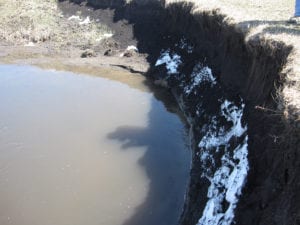 Sedimentation and Erosion
Sedimentation and Erosion
Overtime sediment builds up from incoming rivers, streams, and runoff. As sediment builds up reservoirs become shallow and there is often an decrease in water clarity. There is also a loss of fish habitat as sediment enters and settles in the reservoir. Poor land-use practices increase sediment accumulation by loosening soils that are then carried by run-off into a reservoir. Incoming sediment carrying nutrients and pollutants can result in a lake becoming more eutrophic.
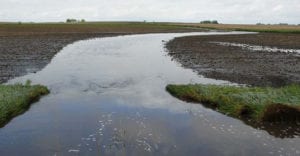 Reservoirs also can experience shoreline erosion from wave action and fluctuating water levels caused by things like drought or water use. Silt from eroded stream banks is deposited in the upper portions of reservoirs causing excessive shallow areas that reduce the capacity of the reservoir to support aquatic life, recreational activity, and ability to provide flood control and municipal water supply. Homeowners and parks also like to have a clear area by the water so people can see the reservoir and enjoy the view. However the view often comes at a cost. As vegetation near the reservoir is removed the shoreline can start to erode. Erosion leads to very steep shorelines that remove spawning habitat for lots of fish.
Reservoirs also can experience shoreline erosion from wave action and fluctuating water levels caused by things like drought or water use. Silt from eroded stream banks is deposited in the upper portions of reservoirs causing excessive shallow areas that reduce the capacity of the reservoir to support aquatic life, recreational activity, and ability to provide flood control and municipal water supply. Homeowners and parks also like to have a clear area by the water so people can see the reservoir and enjoy the view. However the view often comes at a cost. As vegetation near the reservoir is removed the shoreline can start to erode. Erosion leads to very steep shorelines that remove spawning habitat for lots of fish.
Solutions
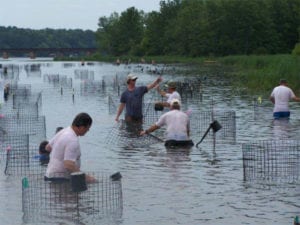 There are many solutions to combat aging reservoirs. For instance, planting native aquatic vegetation provides cover for small fishes and will increase production of bass and other shoreline-oriented fishes. When you begin placing aquatic plants in the reservoir, you need to be protect them from carp, turtles and other plant eaters by using fences or other structures. This helps give the aquatic vegetation a chance to establish and spread to surrounding areas.
There are many solutions to combat aging reservoirs. For instance, planting native aquatic vegetation provides cover for small fishes and will increase production of bass and other shoreline-oriented fishes. When you begin placing aquatic plants in the reservoir, you need to be protect them from carp, turtles and other plant eaters by using fences or other structures. This helps give the aquatic vegetation a chance to establish and spread to surrounding areas.
Likewise installing artificial habitat increases available fish habitat. There are many artificial structures made from environmentally safe materials that address a variety of issues like spawning habitat or cover from predators. Many of these structures can be purchased or built from things you can find a home improvement store.
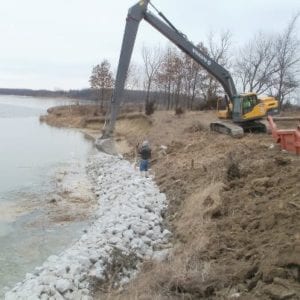 You can also reshape and vegetate shorelines to stabilize eroding shorelines. However, it is only practical on reservoirs that have minimal water level fluctuation. When reservoirs have larger water fluctuations, aquatic vegetation ends up stranded or too far underwater to survive. When dealing with reservoirs that fluctuate, one of the best ways to reduce shoreline erosion is to place rocks or rip-rap along the eroding shoreline.
You can also reshape and vegetate shorelines to stabilize eroding shorelines. However, it is only practical on reservoirs that have minimal water level fluctuation. When reservoirs have larger water fluctuations, aquatic vegetation ends up stranded or too far underwater to survive. When dealing with reservoirs that fluctuate, one of the best ways to reduce shoreline erosion is to place rocks or rip-rap along the eroding shoreline.
One way to address siltation is by dredging the reservoir. This is often costly to do because it involves draining the reservoir and physically removing the silt is buildup. Although it is costly, it is extremely beneficial especially in a eutrophic reservoir that has internal nutrient loading. When you remove the nutrient rich sediment you can improve the water quality of the reservoir.
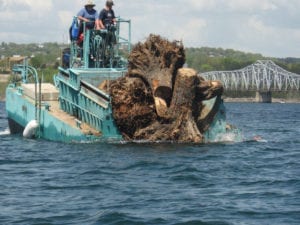 Another way to address reservoirs with high sediment input is to construct small reservoirs or ponds upstream of the reservoir. These small reservoirs or ponds are designed to trap the silt and nutrients. They are also effective in improving water quality in smaller reservoirs. Another approach to reduce runoff silt and nutrient input is to construct wetlands on the upper ends of reservoirs. These wetlands help filter the runoff prior to entering the reservoir and remove silt and nutrients.
Another way to address reservoirs with high sediment input is to construct small reservoirs or ponds upstream of the reservoir. These small reservoirs or ponds are designed to trap the silt and nutrients. They are also effective in improving water quality in smaller reservoirs. Another approach to reduce runoff silt and nutrient input is to construct wetlands on the upper ends of reservoirs. These wetlands help filter the runoff prior to entering the reservoir and remove silt and nutrients.
Learn more about different Friends of Reservoirs habitat improvement projects!
Become a Contributing Sponsor
Become a part of projects that need your support.

